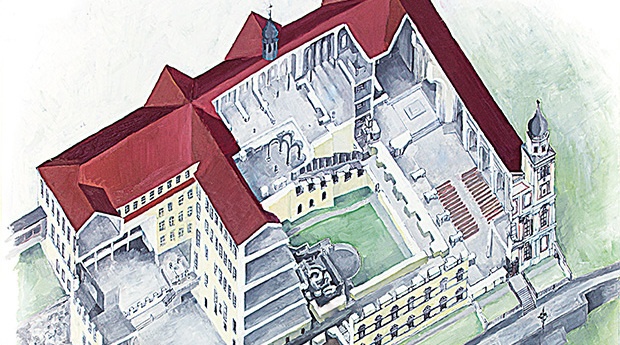Reaching for the sky
Many people aim to reach for the sky in life, but only few follow the path being trodden by Murezi Casanova. At the Benedictine Monastery in Disentis, Switzerland, the novice and trained landscape gardener takes care of the greenery and monastery garden, and will soon add the salvation of his fellow human beings to his list of duties.
1100 metres above sea level is already impressively high. Here in the middle of the Swiss mountains in canton Graubünden’s Oberland, the views reach considerably higher: all the way to the sky if one will. For the last 16 months, Murezi Casanova has taken his place amongst the 22 monks blessed with the opportunity to enjoy the wonderful views on offer in Disentis. In the early morning, the sun climbs majestically over Graubünden’s glistening snow-covered peaks, with the alpine air as pure as the proverbial driven snow.
While still a child, he says, this magical place fascinated him. The qualified landscape gardener hails from a small village 30 kilometres from the monastery, and at the age of 21 is the youngest of the monks. His day kicks off early, before sunrise in fact. At 5.30am, the monks come together to sing hymns, and with their stirring voices fill the great body of the monastery’s church up to its sacral ceiling frescos.


Heavenly alpine view
After breakfast, the morning is dedicated to spiritual singing, psalms and studying the bible and catechism. “Ora et labora, pray and work – that is the mission that God and Saint Benedict have entrusted in us”, Brother Murezi explains, while crickets chirp all around. The young monk eagerly gets down to work, and senses the calling to help people. Later, when he has taken his vows, he will serve as a pastor as well.
Lunch includes meat and vegetables, which often come from the time-honoured garden or the small monastery greenhouse. Swiss chard, for example, is cultivated by Brother Murezi – the green leaves are used to make the canton’s famous speciality, Capuns.
Green cabbage is also thriving, and is not only valued as a dish rich in vitamins, but also turned into a healing ointment. Somewhat to the side of the long table they are eating at, a Brother is sitting and reading from the bible. Speaking is now forbidden. A loaf of bread in a wooden bowl is circulated, each monk cutting a slice off. A jug with water and another with red wine also go round.
Heavenly air
“We monks are continuing a centuries-old tradition”, the novice explains as he swaps his black monk’s habit for grey-green working overalls. Now it is afternoon, and the monk is in his basically furnished room, or “cells” as they are called here. It is time for “labora”, work.
Brother Murezi is particularly proud of the old monastery square. The monk is not only showing his colours today – wonderful tulips are growing, shining red, white and yellow, like dots of paint in a sun-blessed landscape. Diving into a sea of herbs further back, one finds oneself being engulfed by the blissful fragrance of thyme, rosemary and lemon balm. All kinds of shrubs are busy growing serenely under the expert’s benevolent influence.
“I very much like being outdoors”, the novice says. He has short hair, a tender face, and dark glowing eyes. The tolling of bells accompanies him. The ground is steep: Brother Murezi unloads tools from a dark grey implement carrier. “Today I am planting a sequoia”, he laughs, while shovelling earth out of the way.
With technical skill, the novice wraps a canvas sack around the tree’s roots, and lifts the still modestly-large tree with a garden fork carefully out of the earth. “Hundreds of years ago monks were experimenting with this exotic tree species”, he explains. The tree will be planted in front of the monastery on a large meadow, and be free to develop unhindered.













